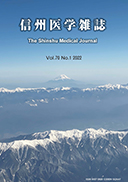Volume 70, Issue 1
Displaying 1-12 of 12 articles from this issue
- |<
- <
- 1
- >
- >|
Foreword
-
2022 Volume 70 Issue 1 Pages 1-2
Published: February 10, 2022
Released on J-STAGE: April 04, 2022
Download PDF (319K)
Notes of Final Lecture
-
2022 Volume 70 Issue 1 Pages 3-7
Published: February 10, 2022
Released on J-STAGE: April 04, 2022
Download PDF (776K)
Review
-
2022 Volume 70 Issue 1 Pages 9-18
Published: February 10, 2022
Released on J-STAGE: April 04, 2022
Download PDF (6465K)
Originals
-
2022 Volume 70 Issue 1 Pages 19-27
Published: February 10, 2022
Released on J-STAGE: April 04, 2022
Download PDF (1448K) -
2022 Volume 70 Issue 1 Pages 29-38
Published: February 10, 2022
Released on J-STAGE: April 04, 2022
Download PDF (536K) -
2022 Volume 70 Issue 1 Pages 39-46
Published: February 10, 2022
Released on J-STAGE: April 04, 2022
Download PDF (272K)
Short Communication
-
2022 Volume 70 Issue 1 Pages 47-51
Published: February 10, 2022
Released on J-STAGE: April 04, 2022
Download PDF (765K)
Current Topics
-
2022 Volume 70 Issue 1 Pages 53-57
Published: February 10, 2022
Released on J-STAGE: April 04, 2022
Download PDF (15742K)
My Choice of Speciality
-
2022 Volume 70 Issue 1 Pages 58
Published: February 10, 2022
Released on J-STAGE: April 04, 2022
Download PDF (321K)
Book Review by Author
-
2022 Volume 70 Issue 1 Pages 59
Published: February 10, 2022
Released on J-STAGE: April 04, 2022
Download PDF (464K)
What's New? -The Latest from the Labs
-
2022 Volume 70 Issue 1 Pages 60
Published: February 10, 2022
Released on J-STAGE: April 04, 2022
Download PDF (257K)
Abstract of Meetings
-
2022 Volume 70 Issue 1 Pages 61-63
Published: February 10, 2022
Released on J-STAGE: April 04, 2022
Download PDF (376K)
- |<
- <
- 1
- >
- >|
